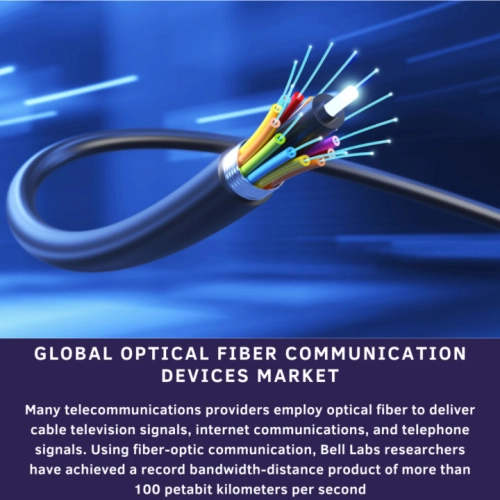
- Get in Touch with Us

Last Updated: Apr 25, 2025 | Study Period:
Fiber-optic communication uses infrared light pulses to transport information over an optical fiber from one location to another. The carrier wave that makes up light is modified to transmit information When high bandwidth, long distance, or immunity to electromagnetic interference are required, fiber is preferable over electrical wiring. Voice, video, and telemetry can all be transmitted using this method of communication over short and long distances.

Many telecommunications providers employ optical fiber to deliver cable television signals, internet communications, and telephone signals. Using fiber-optic communication, Bell Labs researchers have achieved a record bandwidth-distance product of more than 100 petabit kilometers per second.
The global optical fiber communication devices market accounted for $XX Billion in 2023 and is anticipated to reach $XX Billion by 2030, registering a CAGR of XX% from 2024 to 2030.
MEISU ensures higher quality PM fiber devices with high-precision alignment tools and extensive experience in PM fiber products. The location of all the PM fiber stress rods can be maintained consistently even when building a PM fiber array with hundreds of channels. At MEISU, polarization-maintaining optical fiber can also be made to order and manufactured.
The Japanese company Sony, which is renowned for creating a wide range of digital components and commercial goods, has founded a new business. For space companies, the Sony Space Communications Corporation (SSC) will design and produce optical communications equipment. Small optical communications devices will be created by SSC.
By utilizing laser beams to connect microsatellites in low-Earth orbit, they will offer associated services. High-speed communication between tiny satellites will be made possible by the SSC optical communications equipment. The use of conventional radio communications equipment makes it physically challenging to accomplish this. This is due to the latter's need for substantial antennas and high power output.
The "NEC Intelligent Optical Fiber Sensing Solution," which enables Communications Service Providers (CSP) and optical fiber owners from all over the world to use optical fiber as a sensor, has officially started to be sold by NEC Corporation.
By analyzing vibrations picked up by optical fibers using AI, this technology aids in the maintenance of infrastructure by enabling the early diagnosis of anomalies such fiber degradation and assisting in the mitigation of further damage. In order to enable sensing using existing optical fibers that are often used for communications, this solution makes use of NEC's optical fiber sensing technology, one of the first of its kind.
The new tunable laser-diode chip from Mitsubishi Electric Corporation will be used in optical transceivers for optical fiber communication systems, and the company has stated that it will start shipping samples of the product. The new chip is anticipated to decrease the size of optical transceivers while also increasing the capacity of digital coherent transmission.
A 1.55 m light wavelength produced by the new device is employed for digital coherent communication. It is compatible with a variety of wavelengths and meets the 400Gbps optical-transceiver standard (OIF-400ZR-01.0). Manufacturers will have more freedom to optimize package designs for individual optical transceivers if the product is offered as a chip.
Mitsubishi Electric created semiconductor manufacturing technology for the production of distributed-feedback (DFB) laser in mobile base stations and electro-absorption modulator integrated laser diode (EML) in datacenters, which is incorporated into the chip's highly dependable architecture.
New handheld devices from opt Test are perfect for a variety of uses, such as enterprise LANs, data centers, telecommunications, industrial networks, and the aerospace and defense industries.
The OP310 Optical Power Meter, OP350 Optical Light Source, OP360 Bidirectional Insertion and Return Loss Tester, and OP380 Insertion Loss Tester are among the newly released items.
A trusted companion anywhere a handheld solution is required, from outdoors on a boom lift to inside an aircraft or the crawlspace of a building, this new line of fiber optic instruments is tough, simple to use, and offers functionality and automation.
| Sl no | Topic |
| 1 | Market Segmentation |
| 2 | Scope of the report |
| 3 | Abbreviations |
| 4 | Research Methodology |
| 5 | Executive Summary |
| 6 | Introduction |
| 7 | Insights from Industry stakeholders |
| 8 | Cost breakdown of Product by sub-components and average profit margin |
| 9 | Disruptive innovation in the Industry |
| 10 | Technology trends in the Industry |
| 11 | Consumer trends in the industry |
| 12 | Recent Production Milestones |
| 13 | Component Manufacturing in US, EU and China |
| 14 | COVID-19 impact on overall market |
| 15 | COVID-19 impact on Production of components |
| 16 | COVID-19 impact on Point of sale |
| 17 | Market Segmentation, Dynamics and Forecast by Geography, 2024-2030 |
| 18 | Market Segmentation, Dynamics and Forecast by Product Type, 2024-2030 |
| 19 | Market Segmentation, Dynamics and Forecast by Application, 2024-2030 |
| 20 | Market Segmentation, Dynamics and Forecast by End use, 2024-2030 |
| 21 | Product installation rate by OEM, 2023 |
| 22 | Incline/Decline in Average B-2-B selling price in past 5 years |
| 23 | Competition from substitute products |
| 24 | Gross margin and average profitability of suppliers |
| 25 | New product development in past 12 months |
| 26 | M&A in past 12 months |
| 27 | Growth strategy of leading players |
| 28 | Market share of vendors, 2023 |
| 29 | Company Profiles |
| 30 | Unmet needs and opportunity for new suppliers |
| 31 | Conclusion |
| 32 | Appendix |